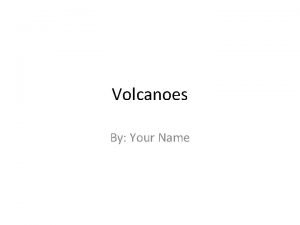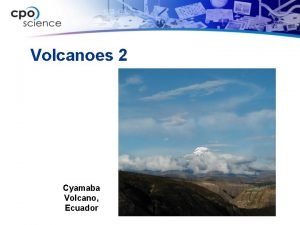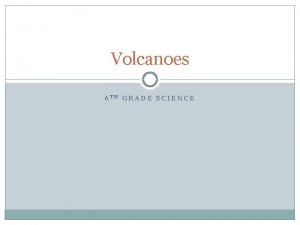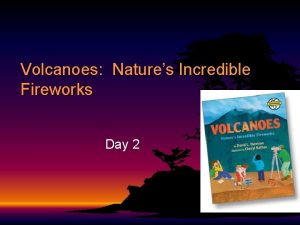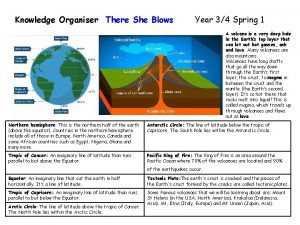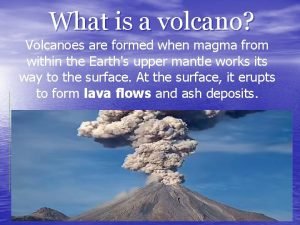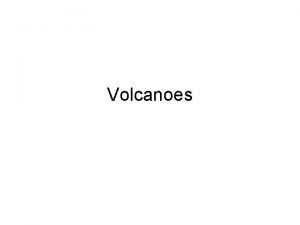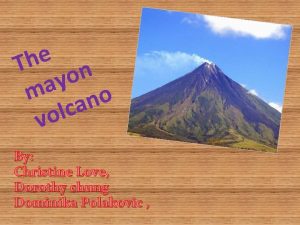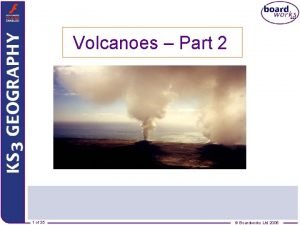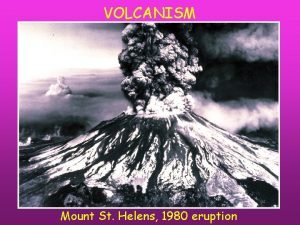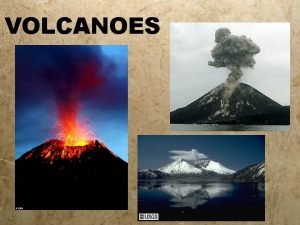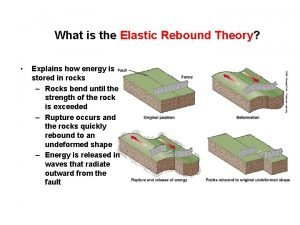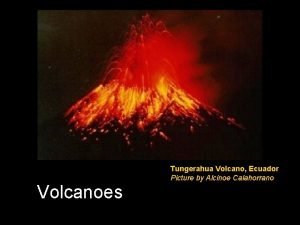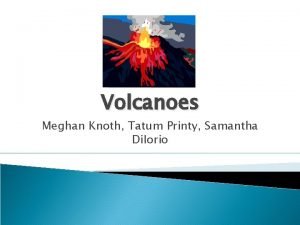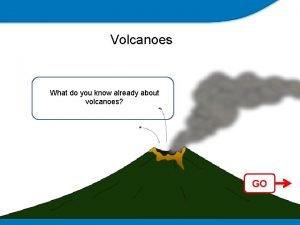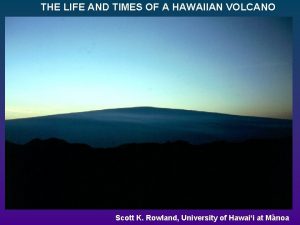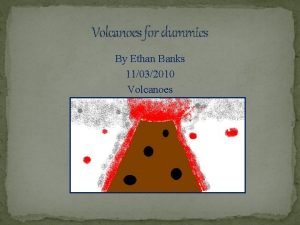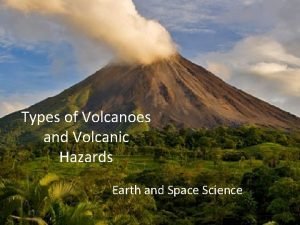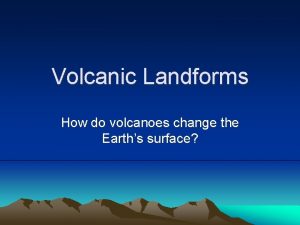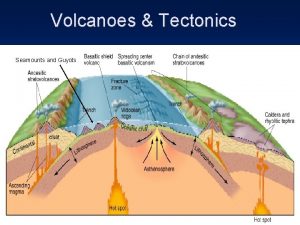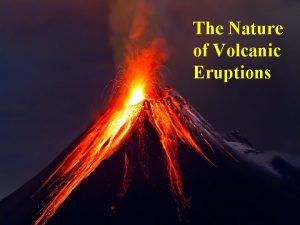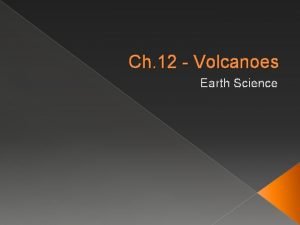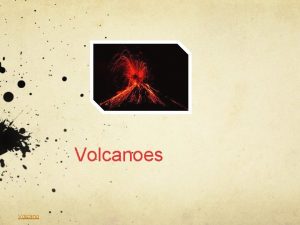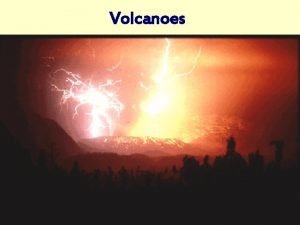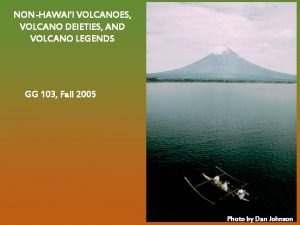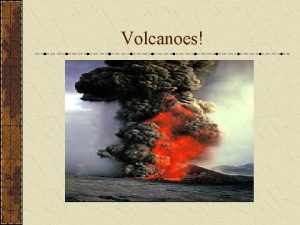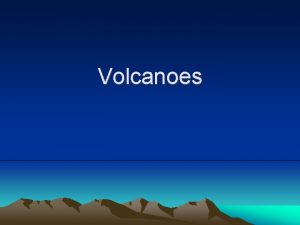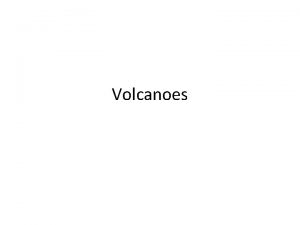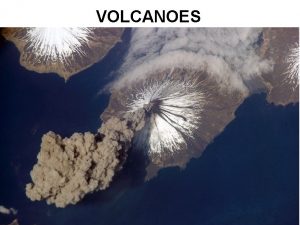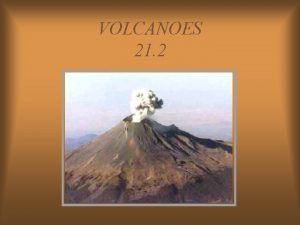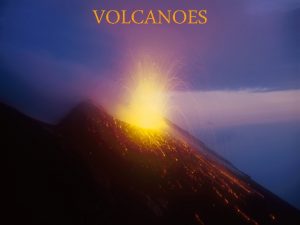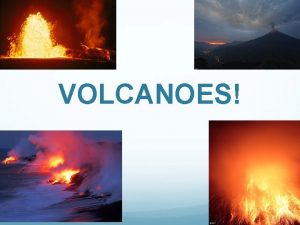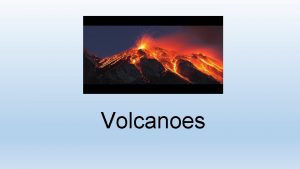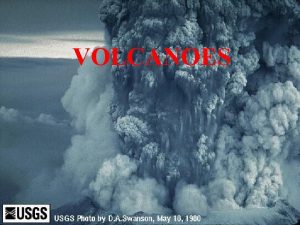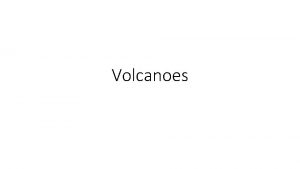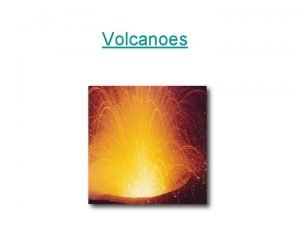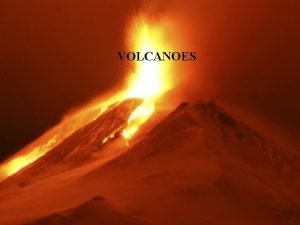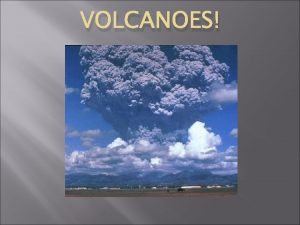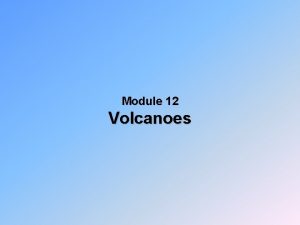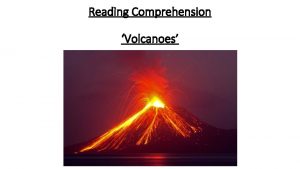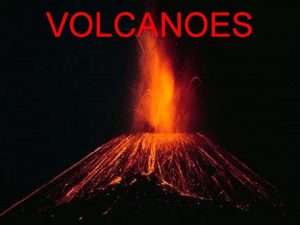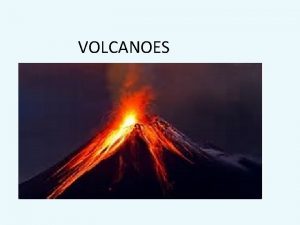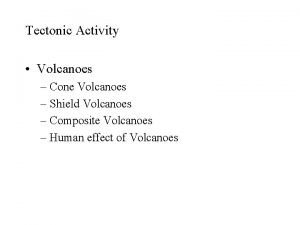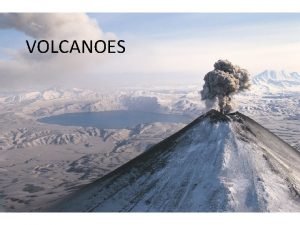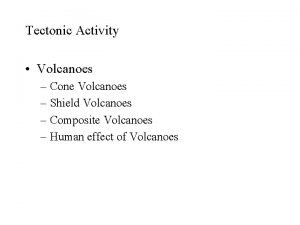Volcanoes What is a volcano A volcano is




























- Slides: 28

Volcanoes

What is a volcano? • A volcano is a mountain that forms when molten rock erupts or flows as lava from an vent or opening in Earth’s surface.

How do volcanoes form? • A volcano forms when molten rock erupts or flows as lava from an opening in earth’s surface and builds up a volcanic cone. • These openings are called vents. • Volcanoes release molten rock, ash, and poisonous gases. All these products result from melting in the mantle or in the crust.

Where do they occur? • Like earthquakes, most volcanoes occur at plate boundaries. • Along a mid-ocean rift, where two plates move apart, divergent boundary, a ridge of underwater volcanoes is formed— Iceland’s volcanoes are part of this kind of ridge. • At convergent boundaries, where an oceanic plate collides with a continental plate—the Andes Mountains in South America.

Ring of Firelocated Around the Pacific Plate

• Not all of Earth’s volcanoes form at the edges of the plates. • Sometimes a volcano forms when a narrow column of hot molten rock breaks through the lithosphere in the middle of a plate. This narrow column of magma is called a hot spot. • A hot spot does not move. However, the plate above it moves forming a chain of volcanoes.


• The island farthest from the hot spot is the oldest. The island nearest to the hot spot is the newest. • The Pacific Plate is moving over the hot spot, which remains stationary. • As the plate moves, the first volcano formed dies out and a second volcano forms over the hot spot, at the new location on the moving plate. • This process continues as the plate continues to move over the hot spot.

The Hawaiian Islands were formed by a hot spot under the Pacific Plate. Today, only the island of Hawaii, located directly over the hot spot, has active volcanoes.

How magma affects a volcanic eruption. • There are three main factors that determine whether a volcano extrudes magma violently or quietly. • The factors are: – magma’s composition—silica content – temperature – amount of dissolved gases it contains.

Quiet Eruption In general, the hot , basaltic magmas flow easily and gently. It is dark-colored and contains a lot of water. This is rich in iron and magnesium and cools to form igneous rocks such as basalt. This lava is thin and runny and most tends to flow easily.

Quiet Eruption In general, the hot , basaltic magmas flow easily and gently. It is dark-colored and contains a lot of water. This is rich in iron and magnesium and cools to form igneous rocks such as basalt. This lava is thin and runny and most tends to flow easily.

Explosive Eruption • Thicker, cooler magmas that contain more silica are more difficult to force through the vent. They may even plug up the vent, causing gases to collect in bubbles and pockets that increase in size and pressure. Eventually that increasing pressure ejects the molten rock from the volcano in a violent explosion. Ex. Mt. St. Helens 1980

1. Strato/Composite Volcanoes Composite volcanoes are made up of alternating layers of ash, cinders, and lava. Because of the Layers, they are also known as Strato Volcanoes. Composite volcanoes switch between quiet eruptions of flowing lava and violent eruptions of thick gas-rich lava. This type of volcano has the most powerful eruptions of all. Their magma is rich in silica and therefore thick. Gases are trapped in the magma, causing eruptions that alternate between flows and explosive activity that produces cinders and ash. Composite volcanoes are


When Mount St. Helens erupted on 18 May 1980, the top 1, 300 ft. disappeared within minutes. Mount St. Helens is a stratovolcano. . Image taken on 10/16/94 from the Space Shuttle. The blast area covered an area of more than 150 sq. miles and sent thousands of tons of ash into the upper atmosphere

Mt. St. Helens • Mt. St. Helens - before 5/18/80 • Mt. St. Helens - after 5/18/80

2. Shield Volcanoes • Shield Volcanoes look like a Spartan’s shield. These broad, slightly dome-shaped volcanoes are the world’s largest. • Volcanoes with broad, gentle slopes and built by eruption of fluid basalt lava are called shield volcanoes. • Basalt lava tends to build enormous, low angle cones because it flows across the ground easily. • The largest volcanoes on Earth are Shield Volcanoes.


Cinder Cones • A cinder cone volcano is built up from ashes, cinders, and rocks that burst from Earth during violent eruptions. • The rocks fall back to Earth near the opening. • At the same time, hot ash covers a larger surrounding area. • Cinder cones erupt for a very short amount of time. Most cinder cones have a bowlshaped crater at the summit and rarely rise more than a thousand feet or so above their surroundings.


Volcanoes are Unpredictable • Volcanoes are rather unpredictable. Some erupt regularly, others have not erupted in modern history. Scientists classify them as active, dormant or extinct.

Active Volcanoes • An active volcano is one that erupts whether continually or periodically such as Mount Katmai in Alaska and Mount St. Helens in the Cascade Range.

Dormant Volcano A volcano that has been known to erupt within modern times but is now inactive is classified as a dormant volcano. Mount Rainier in Washington state is an example of a dormant volcano in the United States.

Extinct Volcano A volcano not known to have erupted within modern history is classified as an extinct volcano. They have been worn away almost to the level of their magma chamber. Scientists can be wrong. Mount St. Helens was considered to be extinct but erupted after long periods of inactivity.

Signs of an upcoming eruption: Different from predicting a flood or an earthquake in that volcanoes usually shows signs of "awakening" before they erupt, giving geologists time to monitor the precursory events.

Predicting Eruptions • Geologists use sensitive instruments to monitor an active volcano to determine if magma is approaching the surface. Signs that a volcano is about to erupt include: • increasing temperature of hot springs near the volcano, • changes in the shape of the volcano or surrounding land, • an increase in hot gas and ash from the vent, • and small earthquakes around the volcano.

Engineering The best form of building engineering we have developed so far to prevent injury, death, and loss of structures during volcanic eruptions is to NOT BUILDING NEAR THEM!
 Taal volcano is an example of_______ volcano
Taal volcano is an example of_______ volcano N
N Ring of fire volcanoes
Ring of fire volcanoes Name volcanoes
Name volcanoes Volcanoes nature's incredible fireworks
Volcanoes nature's incredible fireworks Volcanoes knowledge organiser
Volcanoes knowledge organiser How do volcanoes work
How do volcanoes work Volcanic belts form along _____.
Volcanic belts form along _____. Differentiate active and inactive volcanoes
Differentiate active and inactive volcanoes How are volcanoes made
How are volcanoes made Magma chamber
Magma chamber Where are volcanoes
Where are volcanoes Types of volcanoes
Types of volcanoes How are volcanoes classified?
How are volcanoes classified? How volcanoes form
How volcanoes form Active volcanoes map
Active volcanoes map Constructive forces and destructive forces
Constructive forces and destructive forces Shield volcanoes
Shield volcanoes What do you already know about volcanoes?
What do you already know about volcanoes? Chapter 8 earthquakes and volcanoes
Chapter 8 earthquakes and volcanoes Volcanoes on oahu
Volcanoes on oahu Paboeboe
Paboeboe Types of volcanoes
Types of volcanoes Laccolith
Laccolith Factors affecting magma viscosity
Factors affecting magma viscosity Three main ways volcanoes are created
Three main ways volcanoes are created Big island size broad slightly domed
Big island size broad slightly domed How are volcanoes formed
How are volcanoes formed Volcanoes of italy map
Volcanoes of italy map
